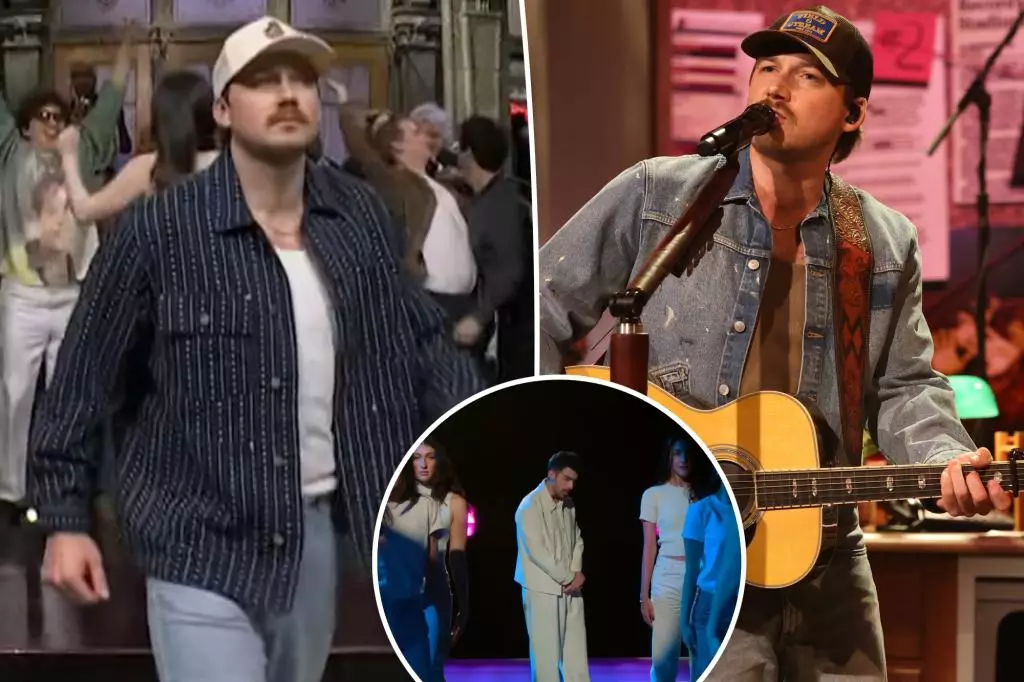This past weekend on Saturday Night Live (SNL) turned into an unexpected spectacle when country sensation Morgan Wallen declined to perform in a sketch, leading to Joe Jonas swooping in at the last moment. This incident epitomizes the unpredictable nature of live television and the multi-faceted relationships between celebrities in the entertainment industry. According to sources close to the event, Wallen wasn’t just apathetic toward the sketch but also seemed unapproachable during his time on set. The 31-year-old star, celebrated for his hit “Whiskey Glasses,” showcased a distinct disengagement, raising eyebrows and prompting speculation among fans and insiders alike.
All Eyes on SNL
Wallen’s presence as the musical guest was one thing, but his reluctance to engage further in the evening’s festivities painted a different picture. SNL, renowned for its ability to blend humor with topical commentary, thrives on its interactive and collaborative nature, especially in sketches that often involve all-star ensembles. The sketch “Big Dumb Line,” which humorously tackled the trials and tribulations of waiting in long lines in New York City, featured a plethora of SNL cast members and the newly appointed host, Mikey Madison. With Jonas picking up the slack, the sketch turned into a lighthearted tête-à-tête, which was in stark contrast to Wallen’s reserved demeanor.
Why the Hesitation?
The reasons behind Wallen’s withdrawal from participating in the sketch remain nebulous. His representatives did not provide comments when approached, leaving both fans and commentators trying to piece together his motivations. Notably, Wallen’s abrupt exit during the show’s closing credits—leaving fellow cast members and audience members in a state of confusion—could suggest underlying discomfort or perhaps even tension. The choired chorus that was distinctly buoyant contrasted starkly with Wallen’s seemingly heavy-hearted attitude.
However, not all was bleak, as Wallen managed to carry through with his musical performance. While this was an obligation, it begs the question of whether he is fully invested in his career and the collaborative aspects it entails. Was there an off-stage reason for his perceived coldness? Is there a simmering tension between Wallen and the creative team of SNL? After all, progress often necessitates a spirit of camaraderie—something that was noticeably absent in Wallen’s demeanor during the production.
Another Perspective: The Role of Live Television
This segment of SNL also raises critical commentary on the pressures of live television. The environment is charged, with personalities clashing and artistic tensions rising. Wallen’s prior controversies surrounding his behavior have already cast a spotlight on him, but this incident furthers the narrative. Whether it’s a refusal to engage or simply the stress that comes with performing live, Wallen’s actions point toward a larger existential critique of how artists manage their public personas in real-time settings.
Moreover, Jonas’s seamless transition from a last-minute addition to a central figure in the sketch illustrates the brilliance of live performance where adaptability is key. He not only rescued the sketch but injected it with a charming energy that resonated with viewers.
Media Speculation and Public Interest
In the aftermath, media speculation has run rampant. Rumors questioning Wallen’s relationship with the cast have emerged, coupled with reports that point toward a more benign narrative where Wallen has exhibited similar behavior during rehearsals. The contrast displayed through various sources highlights how easily things can be misconstrued in the public sphere. It is crucial to consider the character of Wallen, who, despite his star status, is still a human being capable of making personal choices—be it in his interactions or lack thereof.
As keen observers of celebrity culture, we must tread carefully, distinguishing reality from conjecture. The dialogue surrounding Wallen serves not just to amuse but also to engage us in discussions about social expectations of stars, the pressures of celebrity, and the intricate machinery behind live performances.
In the grander scheme, these events serve as a mirror reflecting the complexities of modern stardom, urging us to contemplate the real ramifications behind our fleeting perceptions of public figures. Each of these artists brings their narrative, adding richness to our shared cultural tapestry, yet they navigate a space fraught with unpredictable interplay.

